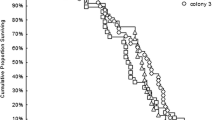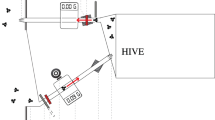Summary:
We recorded lifetime foraging activity and survivorship of individual honey bees foraging under natural settings. Bees experienced a constant probability of death per unit time away from the colony. This leads to a log-linear survivorship curve of type II. Most bees died before reaching senescence. The patterns of survivorship are likely to influence the evolution of foraging behavior, and this result suggests that age-independent factors such as predation could play a strong role in selection of foraging range and other parameters. Our result is contrary to the pattern expected if the survivorship of individual honey bee foragers is determined largely by a limited lifetime budget of energy expenditure, which would imply a low probability of mortality early in a bee's foraging life, followed by a sharp increase in mortality late in life, when either physiological or mechanical wear cause death.
Similar content being viewed by others
Author information
Authors and Affiliations
Additional information
Received 12 December 1995; revised 28 May 1996; accepted 3 July 1996.
Rights and permissions
About this article
Cite this article
Visscher, P., Dukas, R. Survivorship of foraging honey bees. Insectes soc. 44, 1–5 (1997). https://doi.org/10.1007/s000400050017
Issue Date:
DOI: https://doi.org/10.1007/s000400050017




